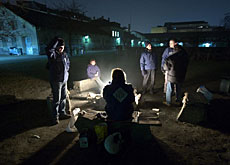Bullish economy cuts working poor figures

The number of working people who live below the poverty line has dropped in Switzerland thanks to a more robust economy.
But church charity Caritas Switzerland has accused the government of fudging its figures.
The Federal Statistics Office reported on Monday that 8.5 per cent of the 4.226 million Swiss between the ages of 20 and 59 live below the poverty line – down from 9.1 per cent in 2000.
The percentage of working poor, those who work but who still find themselves below the poverty line, dropped from five per cent to 4.2 per cent over the same period to a total of 125,000.
Anyone who works at least one hour a week for a salary is considered to be part of the working population.
In March the State Secretariat for Economic Affairs (Seco) revealed the Swiss economy expanded by 2.7 per cent in 2006, the fastest rate in six years.
That news came a day after the International Monetary Fund (IMF) reported in its annual assessment that as economic expansion entered its fourth year “growth [in Switzerland] is balanced, inflation is low and employment is strong”.
The Federal Statistics Office said single-parent and larger families, people without formal training and foreigners from outside the European Union were more likely to belong to the working poor.
Self-employed people, especially those with no employees of their own, were also likely to end up below the poverty line.
The type of employment contract can also have an influence on salaries. People with a fixed-term contract or those re-entering the workforce are likely to earn less.
Criticism
There was criticism however from Jürg Krummenacher, director of the church charity Caritas Switzerland and president of the Federal Coordination Commission for Family Issues.
While Krummenacher agreed with the general finding that the favourable economy was reducing the number of working poor, he accused the statistics office of using new parameters for defining poverty without mentioning the fact in the press release.
“The Federal Statistics Office has introduced a new definition of poverty based on guidelines set out by the Swiss Conference of Social Institutions,” he told swissinfo.
“But it is not clear to us how this has been defined – the new figures are 40 per cent below the office’s own figures for 2004.”
He said poverty is not just a question for the statistics office, but also a political decision.
“Poverty remains one of the major social problems in Switzerland, especially among children and adolescents,” said Krummenacher, who also criticised the statistics office for not including people outside the 20-59 age range in their figures.
Caritas has estimated there are a total of one million people living in poverty in Switzerland.
Eric Crettaz from the Federal Statistics Office added that the same calculation methodology had been used over the entire five-year period.
For its part, the Swiss Conference of Social Institutions said it was pleased its guidelines were being used, but added that the Federal Statistics Office had been conservative, leaving out for example dentist’s bills or the additional costs for schoolchildren.
swissinfo with agencies
The number of poor workers went down after the turn of the century, according to the Federal Statistics Office.
Since 2000, the working poor have represented at most 7.9 per cent of the working population, an improvement over the late 1990s, when the rate climbed as high as nine per cent.
This period coincided with a higher unemployment rate and fewer opportunities on the job market.
According to official figures from 2004, the Federal Statistics Office defines the poverty line as the total of rent, obligatory health insurance and basic needs plus or minus a monthly contribution of SFr100 per household member over 16 for further necessary expenditures.
In Switzerland, a single person earning less than SFr2,200 ($1,800) a month – after tax and social security are deducted – is considered to be below the poverty line. For a single parent with two children under 16 it is SFr3,800 and for a couple with two children SFr4,600.
An estimated one in seven people in Switzerland live in poverty, among them 250,000 children, nearly 200,000 old age pensioners and more than 600,000 people aged 19 to 64.
While the number of working poor has fallen, official statistics also show that the number of beneficiaries of social aid is on the rise.
The increase is partly due to more stringent rules governing the attribution of unemployment and disability benefits.
The number of people receiving social aid increased by 9% in canton Geneva in 2005, 6.6% in Bern and 5.8% in Zurich (around 50,000 people). The working poor account for 30% of social aid.
The biggest share of this aid goes to unemployed people with no formal training.
In 2004, approximately 220,000 people received some form of social aid, or 3% of the population.

In compliance with the JTI standards
More: SWI swissinfo.ch certified by the Journalism Trust Initiative











You can find an overview of ongoing debates with our journalists here . Please join us!
If you want to start a conversation about a topic raised in this article or want to report factual errors, email us at english@swissinfo.ch.